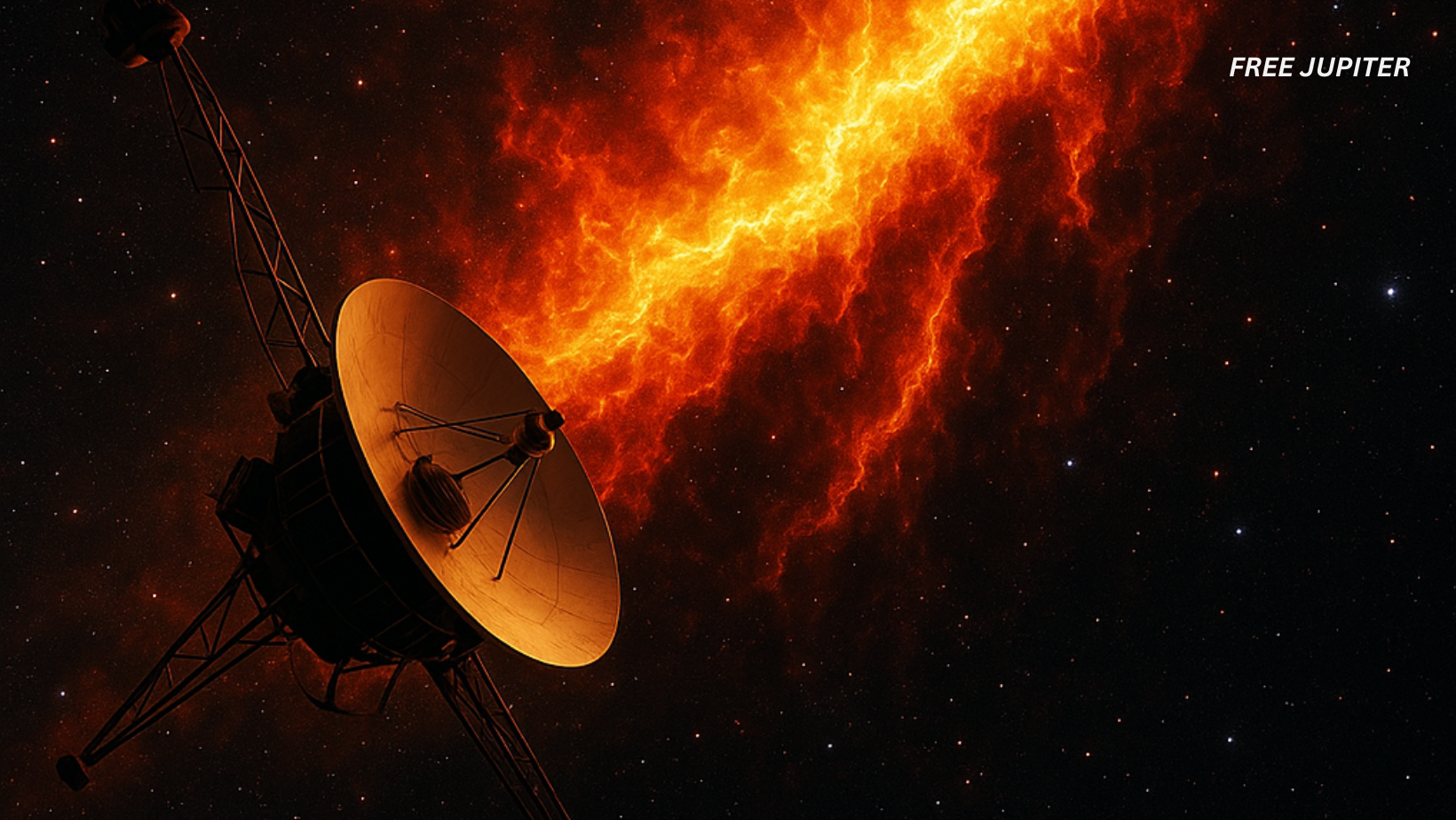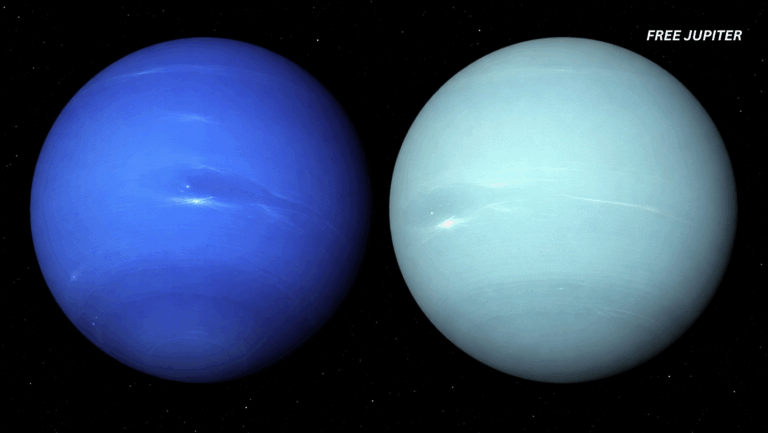Friendly Note: FreeJupiter.com shares general info for curious minds 🌟 Please fact-check all claims—and always check health matters with a professional 💙
In a remarkable journey beyond the familiar confines of our Solar System, NASA’s Voyager spacecraft have unveiled a striking cosmic phenomenon: a blazing, high-temperature region dubbed the “wall of fire.”
This extraordinary discovery lies at the frontier where the Sun’s influence wanes and the vast expanse of interstellar space begins, a boundary known as the heliopause.
The heliosphere, a colossal bubble inflated by the solar wind—a stream of charged particles emanating from the Sun—extends far beyond Pluto’s orbit. The heliopause marks the outer edge of this bubble, where the solar wind yields to the interstellar medium, the sparse matter and radiation filling the space between stars.
To date, only Voyager 1 and Voyager 2 have ventured past this invisible frontier, providing humanity with invaluable insights into the unknown realms beyond our cosmic neighborhood.
The Voyager Probes and the Discovery of the “Wall of Fire”
Launched in 1977 with the ambitious goal of exploring the outer Solar System and the space beyond, the Voyager probes have been traveling for decades. Voyager 1 crossed the heliopause in 2012, becoming the first human-made object to enter interstellar space, followed by Voyager 2 in 2018.
Upon crossing this boundary, both spacecraft detected a dramatic increase in temperature, soaring to between 30,000 and 50,000 Kelvin (approximately 54,000 to 90,000 degrees Fahrenheit). This region of intense heat has been aptly named the “wall of fire.”
This “wall” is not a physical barrier but a zone where the solar wind’s charged particles collide and interact with the interstellar wind, resulting in a heated environment filled with high-energy particles.
Despite the extreme temperatures, the Voyager probes have endured, largely because space is mostly empty, minimizing particle collisions and the transfer of heat to the spacecraft.
Understanding the Heliosphere and Its Boundaries
The heliosphere is essentially a protective bubble created by the Sun’s continuous outflow of charged particles. This bubble stretches well beyond the orbit of Pluto, encompassing all the planets and extending roughly three times Pluto’s distance from the Sun.
The solar wind travels outward until it encounters the interstellar medium, a tenuous mixture of gas and dust that permeates the galaxy.
At the boundary where these two winds balance each other’s pressure lies the heliopause. Here, the solar wind slows down and is deflected, flowing back along the tail of the heliosphere. This interaction shapes the heliosphere’s boundary and forms a bow shock, a turbulent region similar to the waves created by a boat moving through water.
Read more: The ‘City-Killer’ Asteroid Is Now Even More Likely to Hit The Moon in 2032
Magnetic Field Alignments Beyond the Heliosphere
The Voyager missions have also revealed unexpected characteristics of the magnetic fields in this distant region. Instruments aboard Voyager 2 confirmed a surprising observation initially made by Voyager 1: the magnetic field just beyond the heliopause aligns closely with the magnetic field inside the heliosphere.
This alignment was initially uncertain—scientists wondered if it was a localized anomaly or a broader feature of this boundary region.
The confirmation from Voyager 2’s magnetometer suggests that this magnetic alignment is a consistent property of the space just outside our Solar System. This finding challenges earlier assumptions and offers new clues about the complex interactions between the Sun’s magnetic influence and the surrounding interstellar environment.
The Nature and Implications of the “Wall of Fire”
The “wall of fire” is primarily caused by electromagnetic radiation generated by plasma—a state of matter consisting of charged particles—and the intense magnetic fields present in this boundary region. This plasma is hotter and denser than previously expected, marking a stark contrast to the cooler, less dense plasma inside the heliosphere.
Voyager 2’s observations indicate that the plasma density outside the heliosphere increases significantly, confirming and expanding upon Voyager 1’s earlier findings. This dense plasma region acts like a fiery barrier, although it is not solid, but rather a zone of intense electromagnetic activity.
One intriguing aspect of this discovery is the suggestion that the heliosphere may have “leaks,” where particles escape into interstellar space. Voyager 2 detected particles leaking through the heliopause, an unexpected phenomenon given the Sun’s gravity and solar wind should contain these particles.
This leakage could contribute to the thickness and intensity of the “wall of fire,” and implies that the boundary of our Solar System is more dynamic and complex than once thought.
Why This Discovery Matters
The revelation of the “wall of fire” has profound implications for our understanding of the Solar System’s boundary and the nature of interstellar space. It challenges the previous notion that beyond the heliosphere lies a cold, empty void. Instead, the region is alive with energetic particles and magnetic turbulence.
These findings also underscore the importance of having two Voyager probes exploring different parts of the heliosphere’s boundary. Voyager 1 and Voyager 2 are positioned on opposite sides of the heliosphere—one near the “front” and the other near the “side”—allowing scientists to compare data and gain a more comprehensive picture of this complex region.
Moreover, understanding the heliosphere’s interaction with the interstellar medium is crucial for future space exploration. The “wall of fire” represents a natural barrier that spacecraft must navigate to venture deeper into the galaxy. Knowing its properties helps inform the design of future missions and the protection needed for instruments and potential crewed spacecraft.
Read more: This Cement Can Supply Electricity For Homes. Structures May Soon Generate Their Own Energy.
The Continuing Journey of the Voyager Probes
Despite their age and the harsh conditions encountered, both Voyager spacecraft continue to send valuable data back to Earth. Their discoveries have reshaped our perception of the Solar System’s limits and opened new questions about the nature of space beyond.
The “wall of fire” is just one of many surprises these intrepid explorers have revealed. As they journey further into the interstellar medium, the Voyagers will continue to illuminate the mysteries of the cosmos, providing a legacy of exploration that extends far beyond their original mission.
This extraordinary finding by the Voyager probes highlights the dynamic and energetic nature of the space that lies just beyond our Sun’s reach. Far from a quiet void, the boundary of our Solar System is a region of intense activity and complex interactions, a fiery frontier that challenges and enriches our understanding of the universe.










